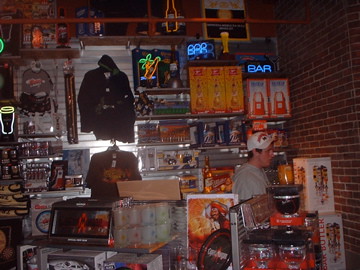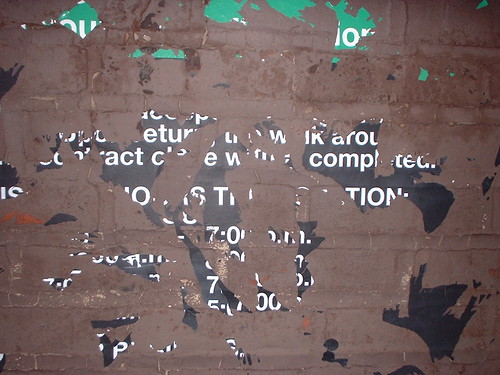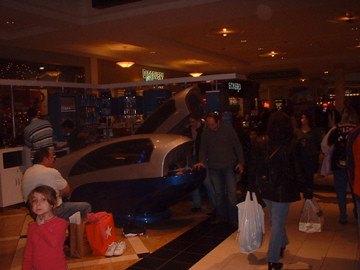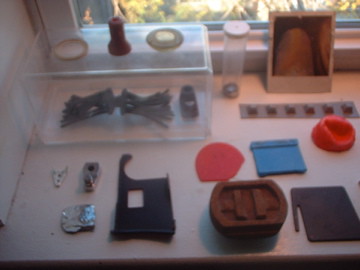

2007.
I. The Human Family.
On Sunday— the free day— a handful of us went to the Museum of Archaeology and Anthropology in West Philadelphia, to weigh human history by the jar. Mummy babies, stupas, funerary urns, tools, weapons, colossi— every object haunted by the accumulated dust, facts, accidents, and aura of its individual history. We all left with more or less the same impression: the collection gave us a sense of the smallness of human history, its continuity rather than discontinuity. Its familial coziness. Staring at a damaged copper stand for a while, I pictured a Mycenaean fumbling around, accidentally dropping the thing and fucking up one of its legs. At the time, they probably just blasphemed their god and tried to straighten out the damage by hand. I saw it plainly as an everyday object, like a coat-hanger or a bar of deodorant.
The whole of human history spans around two or three hundred consecutive fathers. An eyeblink in geological terms, of course. But eerier still is how comprehensible it is even in personal terms. A lucky man, living to the overripe old age of a hundred, has himself seen one fiftieth of all human civilization. With a squint, I could see what it would be like, hypothetically— as a vampire— to experience human civilization from the birth of language to the death of Peter Jennings. As a lived period of time.
Rich noticed another botched bust, with a lopsided face, probably tossed by the sculptor but now deemed priceless purely because it survived the sieve of human disaster. Apparently, in this world, all you have to do is last. This is the meaning of redemption. Every object in the museum, though, lies somewhere between artwork and artifact, expression and impression— every object has its subconscious and conscious aspects. What the little homo faber was making and doing, and what he thought he was making or doing. It’s pretty fun to analyse whole collections— or entire corner shops— in this way.
In any regard, I’ve launched myself into a yet another half-formed hobby, a darkhorse branch of urban archaeology. Well maybe “archaeological” in the way Foucault is an “archaeologist of human knowledge.” For one, I’ve begun a private collection of inexplicable objects— anomic objects. I also want to grid off an encampment, somewhere near a local highway, to run a full archaeological and anthropological analysis on the plot. With chemistry and dead languages. Where did the previous campers piss and shit? What other function did these Slurpee cups and straws serve? What does the acidity differential tell us about its history? Why here rather than that alcove over there? What crimes were committed, what drugs consumed, what hopes dashed? What does it tell us about the time in which they lived— our time?
The other methodology— the one I’m most stoked about, currently— is the anthropological method applied to the flux of experience. Something clumsily or departmentally dubbed “phenomenological anthropology.” The interpretation of circumstances— more accurately, of surroundings— with an inquisitive, anthropological tooth. It began with a game, on a stroll with Kelly Binder. One player-inquirer points out something, eye-spy, in his immediate environment. He then asks the other player-inquirer to identify the object. The first stage of the game is always identification. For instance, a knob here, a weird green electrical box there. Or, the spray marks along roads and sidewalks, the municipal graffiti that help map and mark the utilities for workers— who do you know who can sensibly interpret these hieroglyphics?
Successive stages of the game consist in asking wider, deeper, evermore complex questions: what is this for, how does it work, how is it made, what is it called, when was it made, what happened here, what is the meaning of this, how can this be utilized, how can this be negated— until we have a frighteningly Sherlock Holmesian interpretation of our surroundings. Like language acquisition, what is at first painstakingly and conscious interpreted is later habitually and subconsciously perceived and acted upon. Each piece and line becomes hypermeaningful to us, as the things we have to say run from the intrinsic to the increasingly extrinsic, from material to rhapsody. The game places us, once again, in the seat of a childhood perspective. It stimulates the same— how should I phrase this— pediatrical growth (there is no word in the English language that denotes the adjectivization of the word “child” in a non-belittling way). It is considered healthy, by some, to cease most conceptual metabolism once Necessity has been met and successfully managed. “I can find my way to the store to buy cigarettes— good enough for me.”
But, as Ortega y Gasset himself wrote:
“El hombre es el ser condenado a traducir la necesidad en libertad.”
“Man is the being condemned to translate necessity into liberty.”
To find ways to push our conceptual metabolism beyond Necessity, into arenas and reasons that people will find silly precisely because they are unnecessary. Spending an hour in Home Depot, classifying and deciphering the typical tools and materials of Western Civilization, is unnecessary. Amassing and interpreting spray marks and dirty, found-objects is unnecessary. Reading bodybuilding and a gun collector magazines, precisely because they are emotionally illegible, is unnecessary. Every form of cathexis beyond Necessity will have a gamelike quality to its desires. We need to find better and better excuses to strive for the mastery of Circumstances, and I invite anyone out on a bracing November stroll.
II. Visual Encyclopaedia.
I, still, feel the stunning success of my “archaeology of the immediate,” the method of overcuriosity in my surroundings. That is, whatever I cannot explain in my surroundings— to whatever level of satisfaction— becomes the source of study. The design of containers, the chemistry of solvents, the sociologies of priss Belgian chocolatiers. Inwardly or aloud, I have to answer questions that would not necessarily come about through simple unnavigated floating. When answers elude me, I retreat to Google or Wikipedia or a visual encyclopaedia, or to experts. Omni-directional and omnivorous interest.
What fascinates me is how intricate the human world is becoming, how every curve, circuit, and letter is the product of Design. The whole story and history of our surroundings has this Hegelian sweep to it: Nature being plied and folded into human dimensions so that, in the end result, everything in our surroundings is legible, the outcome of a purpose. Sometimes even the product of micropurposes: the subconscious, the hastily calculated, a compromise of unspoken forces… The idea that humans once had of Eminent Design— that Divine Purpose could be read in Creation— is becoming true, only with discoverably human purposes rather than opaquely divine ones.
The shriek and warble of ambulance sirens. The moats around cutting boards to catch juices. Collapsing streetlamps poles. Toothpaste tubes. Little numbers written here and there, on stickers and bumpers and boxes. Talk about “webs of significance.” The dividing line between Known and Unknown is also pretty interesting, but I’ll save this line for another day.

On the Instructions for Washing, on clothing tags, the number of dots in the diagram indicates the heat at which the clothes should be washed. One being the coldest and five the hottest. Two is lukewarm. Desayunar and déjeuner—which mean breakfast and lunch in, respectively, Spanish and French— literally mean to stop “fasting” (ayunar, jeuner), which is what “breakfast” means. I never noticed. The tanks at gas stations have color-coded caps for refueling, one pattern for ultra, other patterns for regular, vapor recovery, kerosene, diesel and so on. Jet fuel has its own color as well: brown. Of course, the little details are pretty pointless until they are infused either by poetics or a good plan. Tactics.
I discovered the color code rubric that Miss Utility uses to mark her underground utility lines. Red— electrical, cables, or conduit. Orange— communications. Yellow— gas, oil, steam, or petroleum. Green— sewers and drain lines. Blue— potable water. Violet— recalime water, irrigation, slurry. Pink— temporary markings. White— proposed excvation limits or routes. With this you can decipher the hieroglyphs on all American sidewalks and roadsides, especially in the event of another Civil War in the United States. A war to reduce us to a lostcivilization.


III. Anomic Objects.
A collector’s pride— my growing sidewalk aenigma collection of unintelligible and inexplicable found-objects. Objects and artifacts that sit outside the grid of common explanation and apprehension. Welcome snags and foils in my archaeological approach to the immediate.
I haven’t even tried, yet, to impose sense on them with any sort of taxonomy or system. This will come sooner or later. Right now, I’m enjoying their unintelligibility and mysterious shapes for what they are. Floppy rubber tentacles. Glass spheres. Plastic fragments. Some of them suggestive of a vague origin, such as a toy-fragment or auto-part, others defying all analysis. Naturally, the origin of these objects will tell us, statistically, a lot about what we do not understand: auto repair, super-specialized manufacturing, baby toys, crack cocaine, and so forth.
We ask: how does Man mark and alter his environment? By a cycle of aquisition, manufacture, use, and discard. When we find these unintelligible objects, we rely on typology and context to tell us about its origins, use, and meaning. I’m not keeping any record of context, as of now, so this is not really archaeologial, properly speaking. It’s good old-fashioned curio-collection, purposely contextless, in order to give the inexplicability a little more zing.
We ask: in examining these objects, were the marks and impresses made on purpose or by accident? What contributed to its deterioration and discard? Was it sudden or gradual and erosive? What materials belong to the original intent and which are collected through neglect or discard, like dust, grit, shit, rust, grime, stains, glue, or human hair?
Imagine that I produced objects with no use or real history, then asked others to classify and explain them. What would this tell us about our systems, taxonomies, and explanations— about our order of things?
